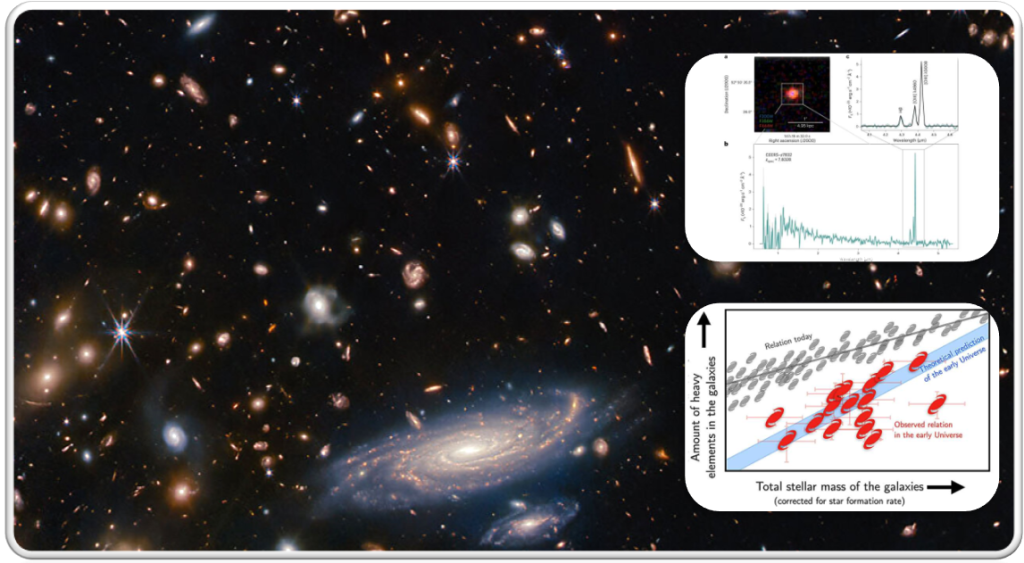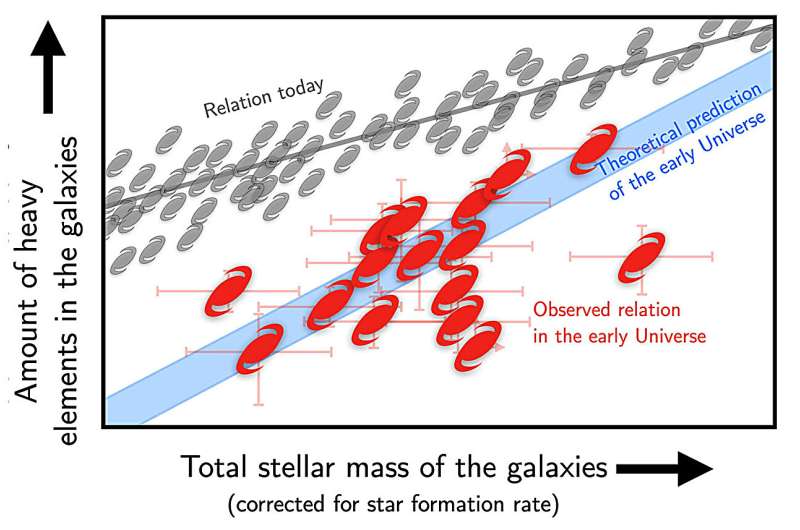With the launch of the James Webb Space Telescope, astronomers can now look back into the past as we get closer to the time when we think the first galaxies were created. Throughout the history of the universe, galaxies seem to have tended to follow a close relationship between the number of stars they form and the number of heavy elements they form.

But for the first time, we see signs that this relationship between number of stars and elements does not apply to early galaxies. The reason is probably that these galaxies have just been created and have not had time to create heavy elements.
The universe is filled with galaxies – huge collections of stars and gas – and when we look into the depths of the universe, we see them near and far.Because the farther away a galaxy is, the longer it takes for light to shine through, we are essentially looking back in time, allowing us to build a visual story of their evolution throughout history of the universe.
Observations have shown us that galaxies over the past 12 billion years, or five-sixths of the age of the universe, have lived their lives in a kind of equilibrium: on the one hand there seems to be a fundamental relationship on the one hand and narrowly between them how many stars they have formed and on the other hand how many heavy elements they have formed. In this context, “heavy elements” refers to anything heavier than hydrogen and helium.
This relationship makes sense, because the universe initially consisted of only these two lightest elements. All the heavier elements such as carbon, oxygen and iron were later created by stars.
![Imaging and spectroscopic data of CEERS-z7382. a, False-color JWST/NIRCam red-green-blue image centered on the example galaxy (blue: F150W, 1.5 μm; green: F277W, 2.8 μm; red: F444W, 4.4 μm). The image scale and corresponding physical size at z = 7.8328 is marked. b, Full NIRSpec prism spectrum covering 0.7 μm to 5.2 μm (cyan) and associated 1σ error spectrum (gray). c, Detail of the spectral region covering the nebular emission lines from the [O III] λλ4960, 5008 doublet and Hβ. The local best-fit line and continuum model is shown by the black curve. Credit: Nature Astronomy (2023). DOI: 10.1038/s41550-023-02078-7 Study reveals cosmic surprises from the dawn of time](https://scx1.b-cdn.net/csz/news/800a/2023/study-reveals-cosmic-s.jpg)
James Webb peers deeper
Therefore, the first galaxies would have been “unpolluted” by heavy elements. But until recently, we haven’t been able to go that far back in time. Besides being very far away, the reason is that the more light travels through space, the redder it becomes. For the most distant galaxies, you have to look into the infrared part of the spectrum, and only with the launch of James Webb were we able to have a telescope large and sensitive enough to see that far.
And the space telescope did not disappoint: James Webb has repeatedly broken his own record for the most distant galaxy, and now it seems we are finally reaching the point where some The first galaxy is created.
In a new study, published September 21 in the journal Nature Astronomy, a team of astronomers from the Danish research center Cosmic Dawn Center at the Niels Bohr Institute and DTU Space in Copenhagen, discovered what actually appears to be one of the first galaxies still forming. Kasper explains: “Until recently, it was virtually impossible to study how the first galaxies formed. in the early universe, because we simply didn’t have the right measuring equipment. This completely changed with the launch of James Webb.” Elm Heintz, lead researcher and assistant professor at the Cosmic Dawn Center.

Fundamental relation breaks down
The relationship between a galaxy’s total stellar mass and the amount of heavy elements is a little more complicated than that. The rate at which the galaxy creates new stars also has something to say. But if you correct that, you get a nice linear relationship: the heavier the galaxy, the heavier the elements.
But this relationship is now questioned by the latest observations. “When we analyzed the light from these 16 early galaxies, we found that they containedmuchfewer heavy elementsthanwouldbeexpected from their stellar mass and number of stars,”explains Kasper Elm Heintz new that they create.
In fact, galaxies werefound to contain on average four times fewer heavy elements than the later universe. These results contrast sharplywith the current model accordingtowhich galaxies evolve in equilibrium throughout the history of the universe.
Predicted by theories
However,this result is not entirely surprising. Theoretical models of galaxy formation, based on detailed computer programs, predict something similar. But now we see it.
The explanation as proposed by the authors in the paper is simply that we are witnessing galaxies being created. Gravity gathered the first clumps of gastogetherandbegan to form stars.
If galaxies then lived their lives undisturbed, stars would quickly enrich them with heavy elements. But at that time, between galaxies there was a large amount of fresh, uncontaminated gas, flowing toward the galaxies faster than the stars could keep up.
“This result gives us our first glimpse of an early stage of galaxy formation that appears to be more closely linked to intergalactic gas than we thought.
“This is one of James Webb’s first observations on the subject, so we’re still waiting to see what the larger, more comprehensive observations currently being made can tell us.”.
“There is no doubt that we will soon understand much better how galaxies and their first structures began to formin the first billion years after the Big Bang,”concludes Kasper Elm Heintz.






